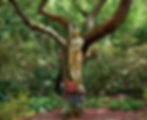Engaging The Renewing Feminine Within
- Kristina Dryža
- Sep 19, 2021
- 4 min read

“People often think of the Goddess as a fertility deity only. Not at all—she’s the muse,” Joseph Campbell elucidates in Goddesses: Mysteries of the Feminine Divine. “She’s the inspirer of poetry. She’s the inspirer of the spirit. So, she has three functions: one, to give us life; two, to be the one who receives us in death; and three, to inspire our spiritual, poetic realization.” (36)
As a Lithuanian, I’ve always been fascinated by how one of the country’s most famous exports, Marija Gimbutas, inspired Campbell. It was her studies of the Great Goddess of the Neolithic world of Old Europe that assisted him in perceiving the goddesses roots in later mythologies, rituals and traditions. He quotes Gimbutas:
The human legs of the vulture … imply that it is not simply a bird but rather the Goddess in the guise of a vulture. She is Death—She Who Takes Away Life, maleficent twin of She Who Gives Life—ominous in flight on great, outspread wings. Despite the incarnate presence of Death, the vulture scenes of Çatal Hüyük do not convey death’s mournful triumph over life. Rather, they symbolize that death and resurrection are inseparably linked.(31)
Many of us long for resurrection, to be called to arise and shepherd the totality of ourselves, including our inner world, out into the external realm. And while the banished and ignored shadow parts of our being may yearn for the light of renewal, it’s only when we orient ourselves to the mysteries of the world of spirit, and to all that speaks to the eternal, that we may find the wisdom, beauty, strength, and rebirth we seek. Symbolically these soul attributes may be pictured as the eternal feminine within us awaiting our attention and foster. (“Das Ewig-Weibliche / Zieht uns hinan.” “The eternal feminine / Draws us on.” Goethe, Faust).
The soul’s underworld is the most fertile ground for the psyche’s deep awakening. The resurrection, as Gimbutas describes, illustrates how essential it is to also meet the Goddess as vulture—a rite of passage, which involves a radical surrender. It’s an experiential process that necessitates being picked down to our very bones (as vultures literally do) to expose and unravel the falsities, masks, and personas that we so frequently employ as protective guises in the everyday, surface world. However, as Campbell reminds us, “It is through the Goddess that you enter the world of the spirit. She is the maze, and she is also your guide.” (39)
The Goddess, whether we call her Gaia or one of various other names, is also the personification of the energies of nature. “The simplest manifestation of the Goddess in the early Neolithic planting traditions is as Mother Earth,” Campbell states. “The Earth brings forth life, and the Earth nourishes life, and so is analogous to the powers of the woman.” (3)
Our soul invites us to house both dormancy (winter) and renewal (spring) by observing what’s disintegrating and rising within us. Again and again we read in the Mystery texts that we must die to our old patterns of behavior and habits of mind so that we may reimagine and refashion ourselves anew. And like the proverbial snake shedding its skin to reveal a new one, death is conquered by the soul’s ongoing regeneration.
Too often we forget that the processes of fertility and creativity initially emerge through dissolution and fragmentation. We’re fearful of the darkness that these movements bring, too weary to explore their mission and hidden, yet sacred, poetry. But it’s the womb space of fallowness and gestation in both vegetative life and in our own soul’s regenerative artistry that is to be sensed. Attentiveness to the “tomb as womb” potentiality must precede our future birth. It’s why we’re required to dwell for lengthy periods of time in the Stygian darkness of the underworld—and heed its tutelage: because it takes that much hidden, obsidian power to birth a new “you,” a new “me,” a new “us” in the personal, societal, and cultural realms.
And so, the feminine impulse for fertile renewal is central to our future birth. As Campbell explains, “Here, when the gods find they are impotent, they have to give the power back to where it ultimately came from: to the female principle. She is the power of life, which lives in us in both its natural and in its so-called supernatural aspects. And in the Greek world we have the rise, then, of the mystery cults, the goddess Demeter, Persephone, and in Egypt, Isis, Nephthys. These are the guides to rebirth, and it’s their symbology that comes in the symbol of the Virgin Mother as the Madonna.” (227)
The myths Campbell references point us to the principles inherent in the cyclical nature of life—the ongoing, agonizing death of the outmoded and resistant old in us in order to prepare for the birth of the new. Gimbutas adds that, “… pre-industrial agricultural rites show a definite mystical connection between the fertility of the soil and the creative force of woman. In all European languages, the Earth is feminine.” (8) For example, the Goddess Persephone is represented visibly as the rebirth of plant life – the seeds of the old crops converging with the new. This dying away and coming into being again is not a singular, once-off event. It’s a continuing, cyclical process and a constant experience. In a sense, it’s the very quintessence of life itself. Indeed, that’s how we meet the Goddess within us.

%20BB.png)





